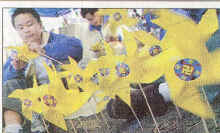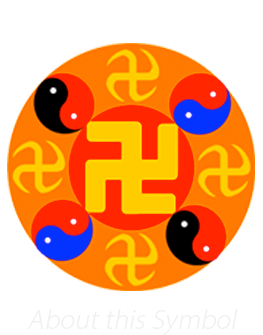10/14/2001
 On the front of Monday's Chapel Hill Herald, at the
top of the page, there was a photo of gaily spinning
pinwheels -- with swastikas at their center.
On the front of Monday's Chapel Hill Herald, at the
top of the page, there was a photo of gaily spinning
pinwheels -- with swastikas at their center.
We received a call from a reader who was angered by the sight of what she and many see as a symbol of evil. But in this photo, the swastika is not being used as a symbol of evil; it is being used for its authentic purpose, as a symbol of [the Buddha school].
The Falun Gong group featured on our front page uses it because the group follows elements of [the Buddha school's] teachings. The Falun wheel, emblazoned at the center of the pinwheels, really consists of nine symbols: the central swastika and -- if one looks closely -- four more swastikas spaced around the perimeter separated by four yin-yang Tao symbols.
Tony Dang, who is in the picture making pinwheels, said Falun Gong is a system that improves physical and mental health. Its spiritual tents are truth, compassion and tolerance, and physical health is improved by exercise similar to the movements of tai chi.
Falun Gong practitioners are visible at Chapel Hill and Carrboro's festivals, and they also practice their movements Saturdays on the UNC campus and Sundays at Duke Gardens.
Dang said his group seeks the visibility of events such as Festivals for two reasons: to share its good, healthy practices with others and to raise awareness of Falun Gong's plight in China.
The latter resonates particularly with Dang -- his brother is in a Chinese labor camp because of his Falun Gong [belief].
It is the hope of Dang and other practitioners that publicizing their movement internationally will encourage the rest of the world to pressure China to end its prohibition of Falun Gong.
The crackdown on Falun Gong began just two years ago, and before that its practice was encouraged in the Chinese media, Dang said, because of its peaceful nature and health benefits.
But the numbers of Falun Gong practitioners kept growing, so that now they outnumber [party's name omitted] members in China, Dang said. With Falun Gong's growth, the Chinese government became frightened, although, Dang said, there is no reason for fear.
"We are just a peaceful group and have nothing to do with politics," he said. "We just want to restore the basic rights, especially in China."
Now the government-controlled media says Falun Gong and its practitioners are wrong.
Dang is from China and is doing post-doctoral cancer research at Duke University Medical Center. He has followed Falun Gong since 1997, when his family told him about it.
His parents and brothers and sisters were all practitioners, although since it was banned by the Chinese government, he hasn't been able to talk to them about it.
"I'm sure the phone is being bugged," he said.
He said he had e-mailed his brother about it, but his brother told Dang not to do so anymore as he feared the police were investigating him and monitoring his e-mails.
In September 2000, Dang's brother was detained by the police and sent to a labor camp. Dang doesn't know his brother's condition now, although labor camp sentences usually last two to three years. He said Falun Gong practitioners usually are beaten at the labor camps.
He said the government is wrong to ban Falun Gong
[...]
As to the Nazi usage of the swastika, Dang likened that to theft. He said it was like having your name stolen.
It's a vivid explanation. If someone evil stole your name, that doesn't mean you are evil and that your name should be sullied.
The swastika has a long, benign history, soiled by its 20th century theft by Adolf Hitler. The word "swastika" actually is derived from the Sanskrit word "svastikah," which means "being fortunate" or "conducive to well-being," according to Internet sources.
It is an ancient symbol, drawn thousands of years ago by an amazingly wide range of cultures with variety of meanings. But its most prevalent usage is a Buddhist symbol of good fortune. In Buddha statues, it often is inscribed on Buddha's chest and on his feet.
If there is a correct usage for this symbol, it undoubtedly is Buddhist, and it is a symbol of good.
[...]
All content published on this website is copyrighted by Minghui.org. Minghui will produce compilations of its online content regularly and on special occasions.
Category: Falun Dafa in the Media









